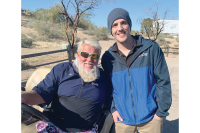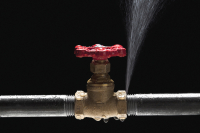The big drawdown
JD McCurry has seen his share of horror stories in his 20 plus years as a well driller. Take the homeowner in Highlands who struck out finding water after building a $1 million house on the property.
McCurry drilled three wells for the homeowner with no luck. Unhappy with the results, the homeowner hired another company to drill two more holes but with the same dry outcome. To this day, the homeowner has trucks of water delivered.
McCurry’s advice: drill before building.
“It’s getting harder to find water,” said McCurry, a driller for Greene Brothers Well Drilling of Sylva. “The water table seems to be dropping every year.”
It’s an important issue in a region where hundreds of wells are drilled every year. Scientists know groundwater isn’t infinite, but beyond that there’s a lot of questions. Exactly how much is there? How quickly is it replenished? How many wells can one mountainside supply?
“Those are very difficult questions to get at,” said Landon Davidson, a regional expert on groundwater with the N.C. Division of Water Quality. “The answer is that we don’t know.”
Related Items
It’s not just the volume of wells being put in the ground that matter, but how much water is being absorbed back into the land. More development equals less absorption, known as groundwater recharge.
“As you develop the land you are going to decrease the overall groundwater recharge,” explained Dr. Mark Lord, a hydrogeologist at Western Carolina University.
In Jackson County, groundwater recharge is being addressed in a pair of proposed development ordinances. Large lot sizes on steep slopes and required open space in developments are both aimed in part at groundwater recharge.
Davidson commended the effort.
“When most subdivisions and lots are planned out, there is no consideration of whether there is enough water,” Davidson said. “There is so much talk now about groundwater sustainability. It is something local governments should be thinking about.”
But due to the lack of data, those writing the Jackson County ordinances are simply having to guess how much natural space is needed to recharge the groundwater for one well. It’s not an impossible calculation, just one with lots of variables.
“It takes a lot of science to get there,” Davidson said.
Factors include the amount of rainfall, the depth of the soil, the type of soil, runoff into creeks and streams, absorption by plants and trees, the slope, the type of underlying rock, and probably a few more.
Such a study was recently done in Guilford County. The conclusion: lots with wells should be a minimum of 2.3 acres to allow for adequate groundwater recharge. That number can’t simply be applied to the mountains, however. For starters, the steep terrain here means more water runs off before it gets a chance to soak in.
“Anytime you increase the slope, you decrease the permeability,” Davidson said.
The mountains are also prone to a shallow layer of soil covering the bedrock. This also causes more water to run off instead of soak in. So it could take significantly more land in the mountains to recharge the groundwater needs for a single well, Davidson said.
A study in Cashiers attempted to measure how many inches of groundwater is absorbed every year. Cashiers, situated on a unique rain-catching plateau, gets 84 inches of rain a year. After evaporation, absorption from trees and runoff into creeks and streams, a whopping 36 inches still reaches the groundwater table. That’s more precipitation than most areas of the country have to start with. The rest of WNC can expect only 12 to 14 inches of groundwater recharge a year, Lord said.
Between the rocks
The groundwater table isn’t a simple concept in the mountains.
“People may think there is an underground river or a plane of water,” said Davidson.
In some parts of the country, it does work that way. Drill down so many feet, and water’s guaranteed. But in the mountains, solid rock lies below the soil. Within that rock, there are tiny seeps called fractures. Those fractures are filled with water below the groundwater table, but you have to hit a fracture to get at it.
“That’s the kicker. It’s not hitting the groundwater table — it’s hitting the fractures,” said Lord, the hydrogeologist at WCU.
That’s why your neighbor might have water, but not you.
“Somebody 50 feet away can come up dry if you don’t hit one of those seeps,” Lord said.
To help his students grasp the concept, he tells them to picture the rock cliffs along the Blue Ridge Parkway with trickles of water seeping out in certain places. The trickles are seeping out of fractures that occur randomly over the face of the cliff.
“It’s a complex maze,” Davidson said of the fractures.
As a drill penetrates the earth, it crosses the path of these fractures in the rock, which in turn feed the well, like a system of pipes.
Well drillers like McCurry can tell how many fractures they hit and how big they are — part of the art of drilling. If the well isn’t crossing paths with many fractures, the driller keeps going deeper hoping to encounter more fractures that could fill the well.
“That’s where you pick the water up is in the seams, the crevices in the rock,” explained McCurry.
The deepest McCurry has drilled is 1,500 feet.
Whether and how quickly you hit enough fractures can be the luck of the draw. Sometimes, there simply aren’t any fractures to cross paths with under a certain piece of ground — as was the case of the unlucky homeowner in Highlands.
Bad luck can happen to anyone, apparently, including a $3 million, 5,000-square-foot home in Rutherford County built by Home and Garden TV as a “Dream Home” in 2006. While it wasn’t touted on the Dream Home circuit, the well had a low-yield, which is common when a driller doesn’t encounter enough fractures.
Although researchers don’t know at what point wells would start to overwhelm the groundwater table across the region, they agree it hasn’t reached that point yet.
“We don’t necessarily believe there is serious depletion going on right now,” Davidson said.
Lord agreed.
The more likely scenario is localized depletion from overwhelming a particular set of fractures.
“I doubt we would see regional impacts yet. You are much more likely to see local issue where the groundwater table is depleted locally from too many people using the same fracture,” Lord said.
While some fractures might extend for miles, the water seeping through it can only serve so many wells. That can lower everyone’s water pressure or yield. There are some stories of drillers using explosives in wells to enlarge fractures, a practice that can cause neighboring wells to go dry in the process.
Groundwater is often taken for granted, Davidson said.
“It’s invisible to most people,” he said. But it’s gaining traction nonetheless.
“Groundwater recharge is really important. We get the majority of our water from rain water seeping through crevices in the rock, which people drill through to get,” said Jeanette Evans of Cullowhee, during a recent presentation on open space and ground water recharge. “It is important we have natural areas that allow the rainwater to collect in the soil and seep down through fissures in the rock and recharge the groundwater table people rely on for wells.”













